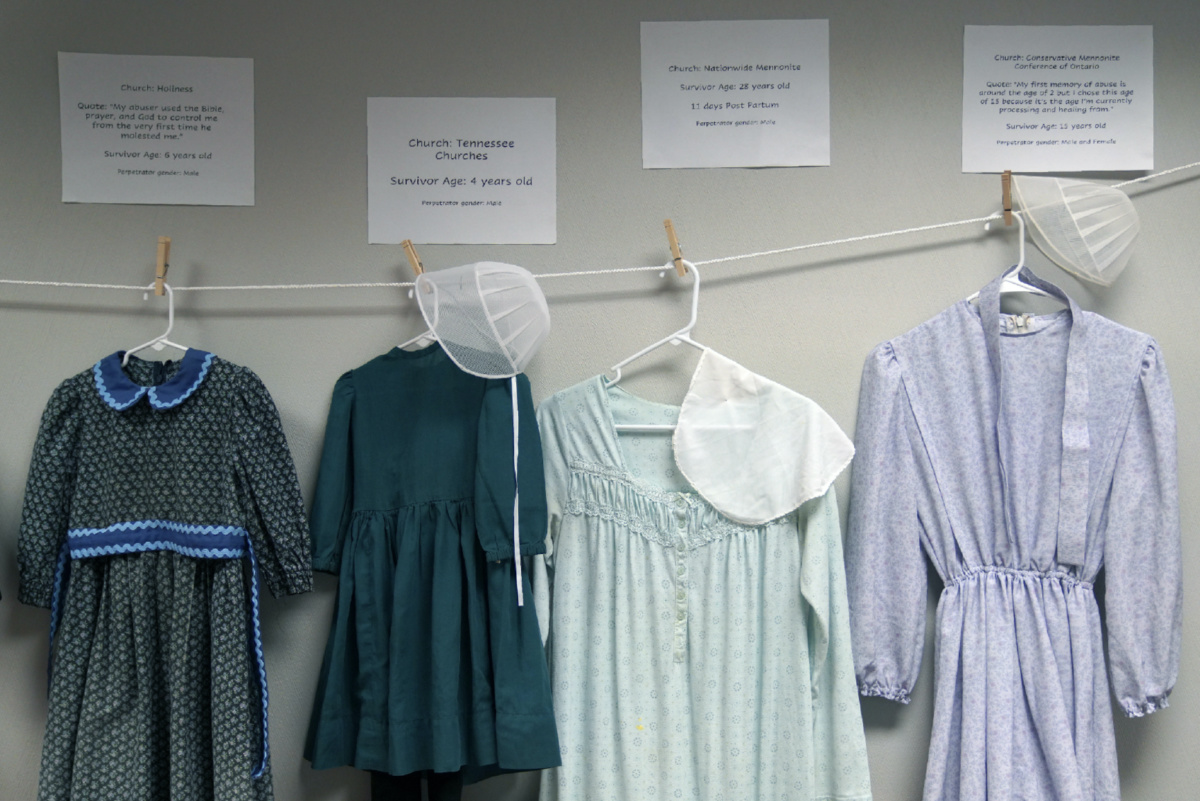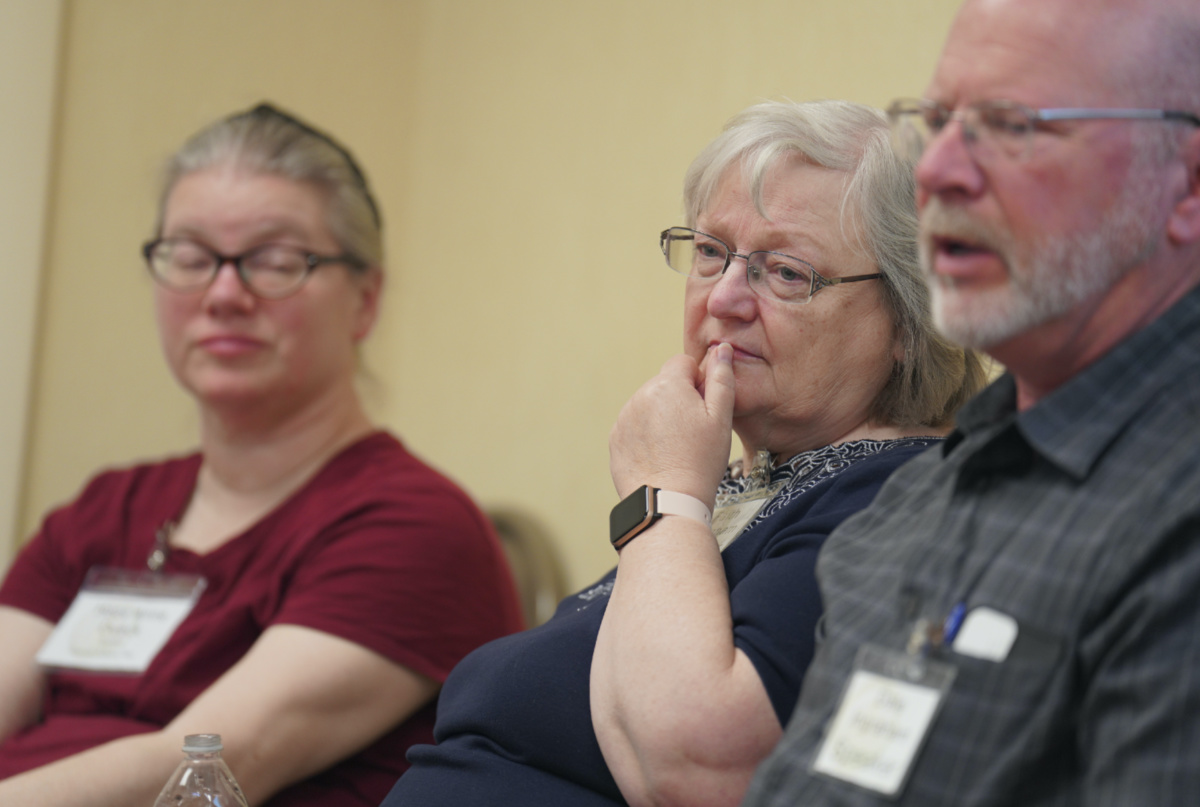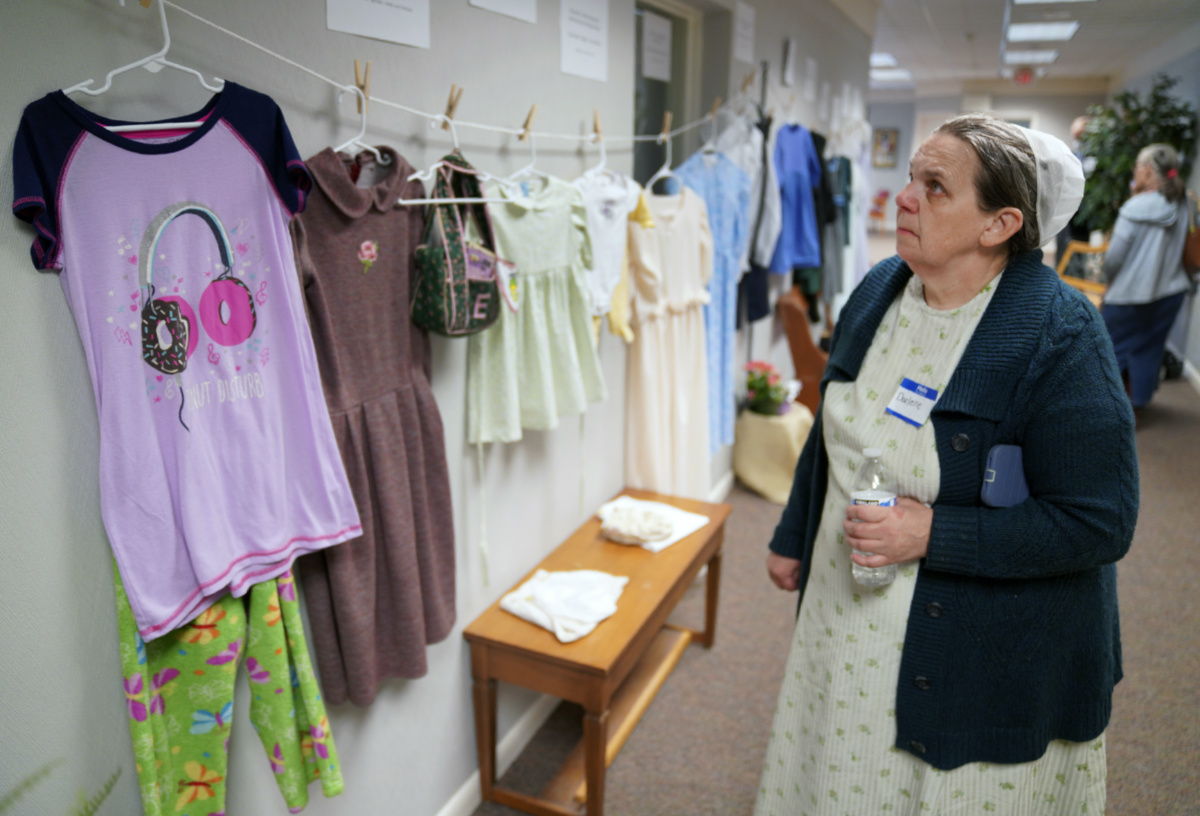
PETER SMITH, of Associated Press, reports on how exhibitions aim to shed light on sex abuse among members of the Amish, Mennonite and similar groups in the US…
Leola, Pennsylvania, US
AP
Clotheslines with billowing linens and long dresses are a common sight on the off-grid farms of Pennsylvania’s Lancaster County, home to the nation’s largest Amish settlement. For many tourists they’re as iconic a part of Amish Country’s bucolic scenery as the rural lanes and wooden bridges.
But for two days in late April, a clothesline with a different purpose was strung in a small indoor exhibit here. Hanging from it were 13 outfits representing the trauma of sexual assault suffered by members of the Amish, Mennonite and similar groups, a reminder that the modest attire they require, particularly of women and girls, is no protection.

Dresses donated by sexual assault survivors from Amish and other plain-dressing religious groups hang on a clothesline beneath a description of each survivors’ age and church affiliation, on Friday, 29th April, in Leola, Pennsylvania. The exhibit’s purpose was to show that sexual assault is a reality among children and adults in such groups. Similar exhibits held nationwide aim to shatter the myth that abuse is caused by a victim’s clothing choice. PICTURE: AP Photo/Jessie Wardarski.
Each garment on display was either the actual one a survivor wore at the time they were assaulted or a replica assembled by volunteers to match the strict dress codes of the survivor’s childhood church.
One was a long-sleeve, periwinkle blue Amish dress with a simple stand collar. The accompanying sign said, “Survivor Age: 4 years old.”
“You feel rage when you get a tiny little outfit in the mail. I didn’t know I could be so angry. Then you start crying.”
– Ruth Ann Brubaker of Wayne County, Ohio, who helped put the exhibit together.
Next to it was a five-year-old’s heavy coat, hat and long, hunter green dress, displayed above sturdy black shoes. “I was never safe and I was a child. He was an adult,” a sign quoted the survivor as saying. “No one helped me when I told them he hurt me.”
There was also an infant’s onesie.
“You feel rage when you get a tiny little outfit in the mail,” said Ruth Ann Brubaker of Wayne County, Ohio, who helped put the exhibit together. “I didn’t know I could be so angry. Then you start crying.”
The clothes on display represented various branches of the conservative Anabaptist tradition, which include Amish, Mennonite, Brethren and Charity. Often referred to as the Plain churches, they emphasise separation from mainstream society, church discipline, forgiveness and modest dress, including head coverings for women.
It was part of a larger conference on awareness of sexual abuse in the Plain churches held on 29th to 30th April at Forest Hills Mennonite Church in Leola and sponsored by two advocacy organisations: A Better Way, based in Zanesville, Ohio, and Safe Communities, of Lancaster, Pennsylvania.

From left, Hope Anne Dueck, co-founder of A Better Way, and Faith and Dale Ingraham, co-founders of the not-for-profit Speaking Truth In Love Ministries, lead a breakout session during a child abuse prevention seminar in Leola, Pennsylvania, on Friday, 29th April. The conference also featured an exhibit that displayed articles of clothing from sexual assault survivors in Amish, Mennonite and other plain-dressing communities. PICTURE: AP Photo/Jessie Wardarski.
Hope Anne Dueck, the executive director of A Better Way and one of the exhibit’s organisers, said many survivors report being told things such as “If you had been wearing your head covering, then you probably wouldn’t have been assaulted,” or “You couldn’t have been dressed modestly enough.”
“And as a survivor myself,” Dueck said, “I knew that that was not the truth.”
“You can be harmed no matter what you’re wearing,” she said. Those who contributed to the exhibit “were wearing what their parents and the church prescribed, and wearing them correctly, and were still assaulted”.
The exhibit was based on similar ones that have been staged at college campuses and elsewhere in recent years called “What Were You Wearing?” They show a wide range of attire with the aim of shattering the myth that sexual assault can be blamed on what a victim had on.
Current and former members of plain-dressing religious communities – not just the Anabaptists but others such as Holiness, an offshoot of Methodism with an emphasis on piety – agreed last year that it was time to hold their own version.
“At the end of the day, it was never about the clothes,” said Mary Byler, a survivor of child sexual abuse in the Amish communities where she grew up. Byler, who founded the Colorado-based group The Misfit Amish to bridge cultural gaps between the Amish and the wider society, helped to organize the exhibit.
“I hope it helps survivors know that they’re not alone,” she said.
Survivors were invited to submit their outfits or descriptions of them. All but one provided children’s attire, mostly girls and one boy, reflecting their age when they were assaulted. The lone adult outfit belonged to a woman who was raped by her husband shortly after giving birth, Dueck said.

Darlene Shirk looks at the clothes of sexual assault survivors from Amish, Mennonite and other plain-dressing religious groups on display at a child abuse prevention seminar, on Friday, 29th April, in Leola, Pennsylvania. Some plain-dressing traditions allow for modern nightwear. Similar exhibits held nationwide aim to shatter the myth that abuse is caused by a victim’s clothing choice. PICTURE: AP Photo/Jessie Wardarski.
Organisers plan to have high-quality photos made of the clothes to display online and in future exhibits.
Plain church leaders have acknowledged in recent years that sexual abuse is a problem in their communities and have held seminars to raise awareness.
But advocates say they need to do more, and that some leaders continue to treat abuse cases as matters of church discipline rather than as crimes to be reported to civil authorities.
Dozens of offenders from Plain church affiliations have been convicted of sexually abusing children in the past two decades, according to a review of court files in several states. Several church leaders have been convicted for failing to report abuse, including an Amish bishop in Lancaster County in 2020.
We rely on our readers to fund Sight's work - become a financial supporter today!
For more information, head to our Subscriber's page.
Researchers and organisers at the conference said they are surveying current and former Plain community members to gather concrete data on what they believe is a pervasive problem.
But the display made a powerful statement on its own, said Darlene Shirk, a Mennonite from Lancaster County.
“We talk about statistics…but when you have something physical here, and because the dress is from the Plain community, it shouts, ‘Look, this is happening in our community!’” she said.
Advocates say that in the male-led Plain churches, where forgiveness is taught as a paramount virtue, people are often pressured to reconcile with their abusers or their children’s abusers.
Byler said that in the 18 years since she reported her sexual assaults to civil authorities, she has heard more stories of abuse in the Plain churches than she can count. Survivors are often isolated from their communities and met with “very victim-blaming statements,” she said.
“Child sexual assault and sexual assault is something that happens…inside of communities from every walk and way of life,” Byler said.






